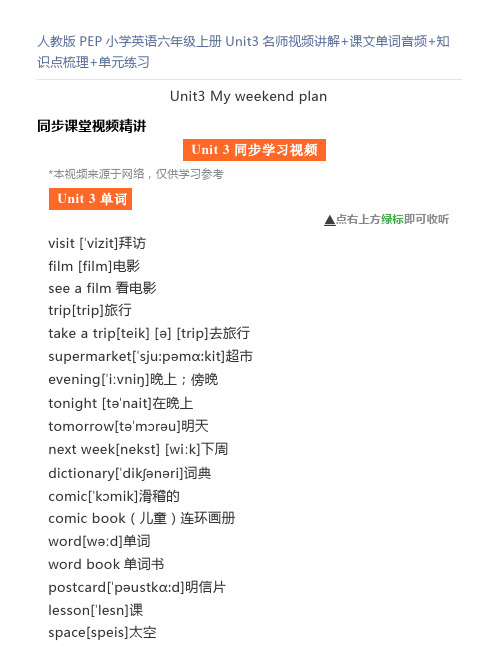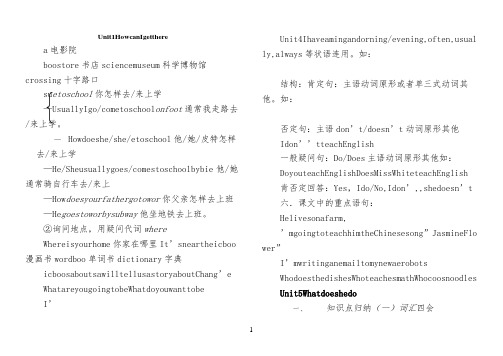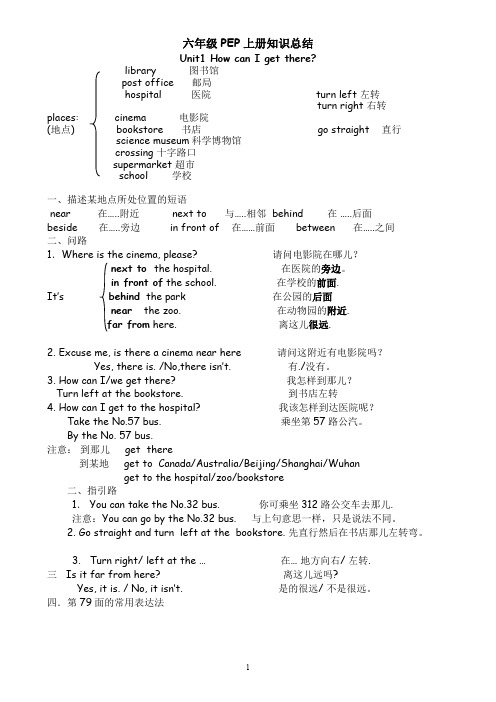最新人教版(PEP)小学英语六年级上册单元知识点总结
- 格式:doc
- 大小:78.50 KB
- 文档页数:8

人教版PEP小学英语六年级上册Unit3名师视频讲解+课文单词音频+知识点梳理+单元练习Unit3 My weekend plan同步课堂视频精讲*本视频来源于网络,仅供学习参考▲点右上方绿标即可收听visit [ˈvizit]拜访film [film]电影see a film看电影trip[trip]旅行take a trip[teik] [ə] [trip]去旅行supermarket[ˈsju:pəmɑ:kit]超市evening[ˈiːvniŋ]晚上;傍晚tonight [təˈnait]在晚上tomorrow[təˈmɔrəu]明天next week[nekst] [wiːk]下周dictionary[ˈdikʃənəri]词典comic[ˈkɔmik]滑稽的comic book(儿童)连环画册word[wəːd]单词word book单词书postcard[ˈpəustkɑ:d]明信片lesson[ˈlesn]课space[speis]太空travel[ˈtrævl](尤指长途)旅行h alf[hælf]一半price[prais]价格Mid-Autumn Festival[mid] [ˈɔːtəm] [ˈfestəvəl]中秋节mid[mid]中央的; 中间的autumn[ˈɔːtəm]秋天festival[ˈfestəvəl]节日together[təˈɡeðə]一起get together聚会mooncake[muːnkeik]月饼poem[ˈpəuim]诗moon[muːn]月亮▲点右上方绿标即可收听Unit 3 My weekend plan 我的周末计划What are you going to do in the nature park? 你要在自然公园做什么?I'm going to draw some pictures. 我要去画画。

Unit1HowcanIgettherea电影院boostore书店sciencemuseum科学博物馆crossing十字路口su etoschool你怎样去/来上学—UsuallyIgo/cometoschool onfoot通常我走路去/来上学。
—Howdoeshe/she/etoschool他/她/皮特怎样去/来上学—He/Sheusuallygoes/comestoschoolbybie他/她通常骑自行车去/来上—How doesyourfathergotowor你父亲怎样去上班—He goestoworbysubway他坐地铁去上班。
②询问地点,用疑问代词whereWhereisyourhome你家在哪里It’snearthe icboo 漫画书wordboo单词书dictionary字典icboosaboutsawilltellusastoryaboutChang’eWhatareyougoingtobeWhatdoyouwanttobeI’Unit4Ihaveamingandorning/evening,often,usual ly,always等状语连用。
如:结构:肯定句:主语动词原形或者单三式动词其他。
如:否定句:主语don’t/doesn’t动词原形其他Idon’’tteachEnglish一般疑问句:Do/Does主语动词原形其他如:DoyouteachEnglishDoesMissWhiteteachEnglish肯否定回答:Yes,Ido/No,I don’,,shedoesn’t六.课文中的重点语句:Helivesonafarm,’mgoingtoteachhimtheChinesesong”JasmineFlo wer”I’mwritinganemailtomynewaerobotsWhodoesthedishesWhoteachesmathWhocoosnoodles Unit5Whatdoeshedo一、知识点归纳(一)词汇四会singer歌手writer作家HongKong香港headteacher校长dancer舞蹈家sea大海worer工人cleaner清洁工factory工厂an邮递员driver司机stay保持businessman商人secretary秘书university大学TVre an渔民money 金钱scientist科学家gym体育馆astudent我是一个学生。

六年级上册英语第一单元知识点对于学前和小学生来说,培养英语学习兴趣,获取英语语感,形成标准的英语语音语调,养成大胆开口讲英语的习惯是最首要的。
下面给大家带来一些关于六年级上册英语第一单元知识点,希望对你们有所帮助。
人教版PEP小学英语六年级上册Unit1知识点梳理science [ saɪəns] 科学museum [mjuː zɪəm] 博物馆post office [pəʊst] [ ɒfɪs] 邮局bookstore [ bʊkstɔː] 书店cinema [ sɪnəmə] 电影院hospital [ hɒspɪt(ə)l] 医院crossing [ krɒsɪŋ] 十字路口turn [tɜːn] 转弯left [left] 左straight [streɪt] 笔直地right [raɪt] 右ask [ɑːsk] 问sir [sɜː] 先生interesting [ ɪntrəstɪŋ] 有趣的Italian [ɪˈtæljən] 意大利的restaurant [ˈrestərɒnt] 餐馆pizza [ piːtsə] 披萨饼street [striːt] 大街;街道get [get] 到达GPS 定位系统gave [ɡeɪv] (give的过去式) feature [ fiːtʃə] 特点follow [ fɒləʊ] 跟着far [fɑː] 较远的tell [tel] 告诉Unit 1 How can I get there重点:询问某地在哪里的问句及其答语询问怎样到某地的句型动词want的用法难点:能够问路并描述路线Wha引导的感慨句四会单词短语science科学museum博物馆bookstore书店cinema电影院hospital医院crossing十字路口tumn转弯left左straight笔直地right右post office邮局三会单词短语ask问sir(对男子的礼貌称呼)先生interesting有趣的Italian意大利的restaurant餐馆pizza比萨饼street大街;街道get到达GPS全球(卫星)定位系统gave(give的过去式)提供;交给feature特点follow跟着far较远的tell告诉get to到达in front of…在……前面惯用表达式1.Excuse me.打搅了。

小学六年级上册英语知识点归纳总结六年级上册英语语法知识点归纳1.现在进行时表示正在发生的事情或进行的动作,常与now,listen,look等词连用,结构是主语+be动词(am,is,are)+动词ing.如:It is raining now.外面正在下雨It is six o’clock now.现在6点了My parents are reading newspapers in the sitting room.我父母正在客厅看报纸Look! The children are having a running race now.看!孩子们正在赛跑问句将be动词移前,否定句在be动词后+not.2.一般现在时表示经常反复发生的事情或动作,常与often,usually,sometimes,always,every day(week year…) on Sundays等词连用。
结构是主语+动词原形;当主语为第三人称单数即he,she,it,Tom,my mother,theboy等词时,动词后加s或es.如:We have an English lesson every day.我们每天都要上英语课Do the boys run faster than the girls? Yes,they do.男孩比女孩跑的快吗?是的'问句借助于do,does否定句借助于don’t,doesn’t,后面动词一定要还原。
3.一般过去时表示发生在过去的事情或存在的状态,常与just now;a moment ago;…ago;yesterday;last ( week;month;year;Monday;weekend);this morning等词连用。
结构是主语+be动词的过去式(was;were)或主语+动词的过去式。
注意:be动词与动词过去式不可同时使用。
如:My earphones were on the ground just now.我的耳机刚刚还在呢。

小学英语PEP六年级上册4-6单元知识点总结Unit 4 I have a pen pal一、重点知识:1、询问某人的爱好--What are sb’s(某人的) hobbies?--主语+like/likes+动词ing.--What are his/Peter’s hobbies?--He likes reading stories.2.区分①--What does he like? 他喜欢什么?--He likes going hiking.他喜欢远足。
②--What is he like? =What does he look like? 他长什么样?--He is tall and strong. 他又高又壮。
3.Do/Does+主语+like+动词ing?某人喜欢...吗?肯定回答结构:Yes, 主语+ do/does.否定回答结构:No, 主语+ don’t/doesn’t.4.also和too都表示‘也’also用在主语后,动词前,too用在句末。
5.宾语6.区别What is his hobby?(单数)What are his hobbies?(复数)7.be interested in对...感兴趣二、动词变三单:1、一般情况是在动词后加-s如:read - reads,write - writes,say – says2、以s,x,ch,sh,结尾的词加-es如:teach - teaches,wash - washes,3、①以辅音字母+y结尾的词变y为i再加-es如:try - tries②元音直接+s如:play -plays4、不规则变化如:have- has go-goes do-does三、动词ing变化规则:1、一般情况下,直接在动词后加-ing如:study ----- studying2、以不发音的e结尾,要去e加ing如:take - taking make -- making dance ---- dancing3、双写词尾字母,再加-ing如:run ----- runningswim----swimmingshop-shopping四、如何把肯定句变成一般疑问句1.如果有be动词和情态动词,直接把他们放在句首,I,we变成you2.句中没有be动词和情态动词,则根据主语借助do/does,后面的动词用原形(I,we变成you,主语是三单才用does 其他用do)补充:be动词包括am,is,are;情态动词:can,must,will,should五.如何变否定句1.句中有be动词或情态动词直接在其后加not2.句中无be动词或情态动词,根据主语用don’t或doesn’t 放在主语后,且后面的动词用原形。

六年级PEP上册知识总结Unit1How can I get there?library图书馆post office邮局hospital医院turn left左转turn right右转places:cinema电影院(地点)bookstore书店go straight直行science museum科学博物馆crossing十字路口supermarket超市school学校一、描述某地点所处位置的短语near在…..附近next to与…..相邻behind在…..后面beside在…..旁边in front of在……前面between在…..之间二、问路1.Where is the cinema,please?请问电影院在哪儿?next to the hospital.在医院的旁边。
in front of the school.在学校的前面.It’s behind the park在公园的后面near the zoo.在动物园的附近.far from here.离这儿很远.2.Excuse me,is there a cinema near here请问这附近有电影院吗?Yes,there is./No,there isn’t.有./没有。
3.How can I/we get there?我怎样到那儿?Turn left at the bookstore.到书店左转4.How can I get to the hospital?我该怎样到达医院呢?Take the No.57bus.乘坐第57路公汽。
By the No.57bus.注意:到那儿get there到某地get to Canada/Australia/Beijing/Shanghai/Wuhanget to the hospital/zoo/bookstore二、指引路1.You can take the No.32bus.你可乘坐312路公交车去那儿.注意:You can go by the No.32bus.与上句意思一样,只是说法不同。
Unit1 How can I get there? 我怎样到达这里?重点单词:where哪里 how 怎样 can能够 near近的 ask问 tell 告诉far远的science科学hospital 医院 museum 博物馆 postoffice 邮局library图书馆 bookstore 书店 usually通常sometimes有时候often 经常know知道near旁边 next to旁边(比near更近) crossing 十字路口turn left 向左转 turn right 向右转go straight直走in front of在…的前面 behind在...的后面重点句子:1.How do you go to school? 你是怎样去上学的?2.where is the restaurant? 餐馆在哪里?ually I go to school on foot.我通常走路去上学。
4.Sometimes I go by bike.有时候我骑自行车去。
、5.问路之前,出于礼貌,我们要说“Excuse me.”与后面的句子要用标点符号隔开。
6.Look at the traffic lights, remember the trafficrules.看着交通灯,记住交通规则。
7.Stop at a red light.Wait at a yellow light.Go at agreen light.红灯停。
黄灯等一等。
绿灯行。
8.Red means stop, yellow means wait, green means go.红色的意思是停止,黄色的意思是等待,绿色的意思是通行。
9.How can I get to the park? 我该怎样到达公园呢?10.You can go by the No.15 bus.你可以坐15路公交车去。
重点知识:1.坐某种交通工具用by,例如:by bike, by train。
六年级 PEP 上册知识点总结 Unit 1 How can I get there?知识点归纳library post officehospital places: cinema ( 地点)bookstore 图书馆邮局 医院 电影院 书店turn left 左转turn right 右转science museum 科学博物馆go straight 直行pet hospital school宠物医院 学校supermarket 超市 shoe store 鞋店Italian restaurant 意大利餐馆crossing 十字路口问路的重点句型:1.Where is the cinema, please? 请问电影院在哪儿?next to the bookstore in front of the school. behind the parkIt’snear the zoo. on D ongfang S treet over there紧挨着书店 在学校的前面. 在公园的后面 在动物园的附近. 在东方大街上 在那边2. Excuse me, is there a cinema near here ?请问这附近有电影院吗?Yes, there is. /No,there isn ’t. 有./没有。
3. How can I get to the hospital? How can I / we get there ?我该怎样到达医院呢? 我/ 我们怎样到那?回答 Turn right/ left at the … 在… 地方向右/ 左转. 或 Go straight向前直走. 或 You can take the No.31 bus. 你可乘坐 31 路公交车去。
4. Is it far from here?离这儿远吗?Yes, it is. / No, it isn ’t.是的很远/ 不是很远。
人教版人教版小学英语六年级上册知识点归纳集团文件发布号:(9816-UATWW-MWUB-WUNN-INNUL-DQQTY-人教版(PEP)小学英语总复习六年级上册知识点Unit1Howcan I get there一、主要单词:museum博物馆 bookstore书店 cinema电影院 turn 转弯 hospital医院 left向左 post office 邮局 science科学right向右straight笔直地 crossing十字路口二、习惯语搭配:post office邮局 science museum科学博物馆 pet hospital宠物医院Italian restaurant意大利餐馆 Beihai Park北海公园 Palace Museum 故宫博物院 go straight直走 turn right/left右/左转 next to挨着in front of...在...前面 near the park在公园附近 on Dongfang Street在东方大街上三、惯用表达式:Excuse me 打扰一下 Follow me, please!请跟着我!四、公式化句型:1、问路的句型及其答语:问句:Where is the + 地点?···在哪儿?答语:It’s + 表示地点的词语。
它···。
2、询问怎么到某地的句型及其答语:问句:How can +主语 + get (to)+地点···怎么到···同义句型:Can you tell me the way to +地点Where is + 地点Which isthe way to +地点答语:Turn +方向+表示地点的介词短语。
···转。
五、例句:Whereisthecinema,please请问电影院在哪里?It’snexttothehospital. 它与医院相邻。
新版PEP小学英语六年级上册1-6单元知识点总结(word版可编辑修改) 编辑整理:尊敬的读者朋友们:这里是精品文档编辑中心,本文档内容是由我和我的同事精心编辑整理后发布的,发布之前我们对文中内容进行仔细校对,但是难免会有疏漏的地方,但是任然希望(新版PEP小学英语六年级上册1-6单元知识点总结(word版可编辑修改))的内容能够给您的工作和学习带来便利。
同时也真诚的希望收到您的建议和反馈,这将是我们进步的源泉,前进的动力。
本文可编辑可修改,如果觉得对您有帮助请收藏以便随时查阅,最后祝您生活愉快业绩进步,以下为新版PEP小学英语六年级上册1-6单元知识点总结(word版可编辑修改)的全部内容。
六年级PEP上册知识总结Unit1 How can I get there?library 图书馆north (北)post office 邮局hospital 医院turn left 左转 turn right 右转places: cinema 电影院(地点) bookstore 书店(东) east west (西)science muse科学博物馆pet hospital 宠物医院crossing 十字路口school 学校south(南) supermarket 超市shoe store 鞋店go straight 直行一、问路1.Where is the cinema, please? 请问电影院在哪儿?next to the hospital。
在医院的旁边。
in front of the school。
在学校的前面.behind the park 在公园的后面It’s near the zoo. 在动物园的附近.on the right/left of the bookstore. 在书店的左/右边。
east of the bank. 在银行的东边。
far from here. 离这儿很远.2. Excuse me, is there a cinema near here 请问这附近有电影院吗?Yes, there is. /No,there isn't. 有./没有。
人教版(PEP)小学英语六年级上册单元知识点 Unit 1 How can I get there ? 一、主要单词: museum博物馆 bookstore书店 cinema电影院 turn 转弯 left向左 right向右 hospital医院 post office 邮局 science科学 straight笔直地 crossing十字路口 二、习惯语搭配: post office邮局 science museum科学博物馆 pet hospital宠物医院 Italian restaurant意大利餐馆 Beihai Park北海公园 Palace Museum故宫博物院 go straight直走 turn right/left右/左转 next to挨着 in front of...在...前面 near the park在公园附近 on Dongfang Street在东方大街上 三、惯用表达式: Excuse me 打扰一下 Follow me, please!请跟着我! 四、公式化句型: 1、问路的句型及其答语: 问句:Where is the + 地点? ···在哪儿? 答语:It’s + 表示地点的词语。 它···。 next to the bookstore, near the hospital/post office, over there, on Dongfang Street, in front of the school... 2、询问怎么到某地的句型及其答语: 问句:How can +主语 + get (to)+地点? ···怎么到···? 同义句型:Can you tell me the way to +地点? Where is + 地点? Which is the way to +地点? 答语:Turn +方向+表示地点的介词短语。 ···转。 at the cinema at the corner near the post office... 五、例句:Where is the cinema, please? 请问电影院在哪里? It’s next to the hospital. 它与医院相邻。 Turn left at the cinema, then go straight. It’s on the left. 在电影院向左转,然后直行。它在左边。 Turn left at the bank。 在银行左转。 六、主题写作:介绍去某地的路线 模板:1、交代目的地的位置及距离 The … is near/next to … It is (not) far from … 2、说明可以采取的交通方式 You can go on foot /by bus /by bike… 3、说明路线 Go straight . Turn left / right at…
范文 How to Get to the Science Museum We are going to the science museum tomorrow.The science museum is next to the hospital.It’s not far from our school.So we can go there on foot.First,go straight from our school.Next,turn left at the post office and walk for about five minutes.Then turn right at the bookstore.We can find the hospital on the right.Walk straight,and we’ll see the science museum. Unit 2 Ways to go to school 一、主要单词:by乘 bus公共汽车 on foot步行 plane飞机 taxi出租车 ship(大)船 subway地铁 train火车 slow慢的 stop停下 always 总是 usually 通常 often经常 sometimes 有时候 never 从来不 二、习惯语搭配: by bike/bus/plane/subway/train/ship/taxi/ferry 骑自行车/乘公共汽车/飞机/地铁/火车/船/出租汽车/渡轮 take the No.57 bus乘57路公共汽车 on foot步行 slow down慢下来 pay attention to注意 traffic lights 交通信号灯 look right向右看 cross the road横穿马路 get off下车 at home在家 traffic rules交通规则 get to到达 get on 上车 be far from…表示离某地远 三、惯用表达式: Wait.等一等. I see. 我明白了 . Go at a green light 绿灯行 Stop at a red light 红灯停 Wait at a yellow light 黄灯等 四、公式化句型: 1、如何询问对方的出行方式:How do you come(to)+地点? 你(们)怎么来···的? 2、如何用must表示必须做某事:某人+must+动词原形(+其它). ···必须···。 3、告诫别人不要做某事的句型:Don’t +动词原形(+其它). .不要/别···。 五、例句: 1. How do you go to school? 你怎么去上学? 2. Usually I go to school on foot. Sometimes I go by bus. 通常我步行去上学。有时候骑自行车去。 3. How can I get to Zhongshan Park ? 我怎么到达中山公园? 4. You can go by the No. 15 bus. 你可以坐15路公共汽车去。 5. I am far from school now. 我现在离学校很远。 6. My home is not far from our school. My home is near our school.我家离学校不远。
六、主题写作: 介绍去上学所采用的出行方式 模板:1、说明自己家到学校的距离 My home is (not) far from /near the school. 2、说明自己的出行方式 I often /usually go to school … Sometimes I go … 3、说明选择该出行方式的原因或好处 It is good exercise./It is fast.
范文 Don’t Be Against the Traffic Rules I go to school from Mondays to Fridays. I go to school by bike at 7:30 in the morning.I have to cross two busy roads.I know the traffic rules well.Slow down and stop at a yellow light.Stop and wait at a red light.Go at a green light.I always ride on the right side of the road.I am never against the traffic rules.
Unit 3 My weekend plan 一、主要单词:tomorrow明天 film电影 supermarket超市 trip旅行 tonight在今晚 evening晚上/傍晚 next week下周 comic连环画杂志 dictionary词典word单词 post card明信片 visit拜访 二、习惯搭配:take a trip去旅行 go for a picnic去野餐 go to the cinema去看电影 learn to swim学习游泳 visit my grandparents看望我(外)祖父母 get together 聚会 go to the supermarket去超市 go ice-skating去滑冰 make a snowman堆雪人 see a film看电影 make mooncakes做月饼 read a poem朗诵一首诗 this weekend这周末 Renmin Park人民公园 next week下周 this morning/afternoon/evening今天上午/下午/晚上 next Wednesday下星期三 三、惯用表达式:What about you?你呢? Here they are!它们在这儿!Can I help you? 我能帮助你吗? Sounds great!听起来很棒! Have a good time!玩得开心! You too.你也是 四、公式化句型: 1、询问对方打算做什么的句型及其答语: 问句:What are you going to do +其它? 你/你们···打算做什么? next week tonight tomorrow this morning/afternoon/evening this weekend... 答语:I’m/We’re going to +动词(短语)原形+其它. 我/我们打算···。 see a film take a trip visit my grandparents watch TV... 2、询问对方打算去哪儿的句型及答语: 问句:Where are you going(+将来时间)? 你/你们打算(···)去哪儿? 答语:I’m/We’re going (to the)+地点. 我/我们打算去···。 3、询问对方打算何时去做某事的句型及答语: 问句:When are you going to +动词(短语)原形? 你/你们打算什么时候···? 答语:I’m/We’re going to +动词(短语)原形+将来时间. 我/我们打算···。 五、例句: What are you going to do on the weekend? 你周末打算做什么? I’m going to visit my grandparents this weekend? 这个周末我打算去看望我的外祖父母。 Where are you going this afternoon? 你今天下午打算去哪里? I’m going to the bookstore. 我打算去书店。 What are you going to buy? 你打算去买什么? I’m going to buy a comic book。 我打算去买一本漫画书。